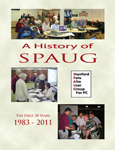 SPAUG is a follow-on to the Homebrew Computer Club, an early computer hobbyist club in Silicon Valley. The Homebrew Club—like similar clubs—was a forum for sharing ideas. It attracted hobbyists and those eager to experiment, many of whom became leaders in personal computing. That Homebrew crowd was on the bleeding edge of the technology that was available at the time.
SPAUG is a follow-on to the Homebrew Computer Club, an early computer hobbyist club in Silicon Valley. The Homebrew Club—like similar clubs—was a forum for sharing ideas. It attracted hobbyists and those eager to experiment, many of whom became leaders in personal computing. That Homebrew crowd was on the bleeding edge of the technology that was available at the time.
At that time, upon the void created by the cessation of the Homebrew computer club, through a miracle of events, personnel, and circumstance, a new club formed which had the inglorious name because of circumstance, the Stanford Palo Alto User Group (for PC) (SPAUG). The Stanford portion of the name came from the fact that, at the time of incorporation, SPAUG was meeting at Polya Hall at Stanford and numbers of Stanford students were an integral part of the club.
Early era between 1983 and 1989
At the beginning of the Stanford Palo Alto Users Group in 1983, the membership had to decide how much dues to charge, set up club library and the Special Interest Groups (SIGs). The meetings were held at Stanford University and at first, every meeting was in a different location until they settled on a room in Polya Hall. A post office box was established for club mail. The Planning Meeting was held just prior to the General Meeting, rather then on separate days as we do now.
The annual dues were $10 at first and then were raised to $25 soon afterwards. Decisions had to be made about club officers, such as President, Newsletter Editor, treasurer, membership, guest speakers, and annual elections. A newsletter had to be established. Kevin Ohlson used typesetting fonts to create the club’s first PrintScreen logo after the first months of newsletters.
 To commemorate and document about 28 years of SPAUG operation, a team of SPAUG members decided that they would write and document the history of SPAUG. Thus was born a project that occupied the time and efforts of its leader Robert Mitchell for two years. John Sleeman. Stan Hutchings, Maury Green, John Buck, and Bev Altman also worked on the history document.
To commemorate and document about 28 years of SPAUG operation, a team of SPAUG members decided that they would write and document the history of SPAUG. Thus was born a project that occupied the time and efforts of its leader Robert Mitchell for two years. John Sleeman. Stan Hutchings, Maury Green, John Buck, and Bev Altman also worked on the history document.
In order to present the entire history of 28 years of PrintScreen, the team amassed an incredible 28-year library of the newsletter, which, in itself is a great achievement. In addition to the PrintScreen library, the group wrote a 40-page historical epistle covering the evolution of the PC and the activities of SPAUG.
The 300-plus issues of PrintScreen and a bound copy of “The History of SPAUG” were presented to the Computer History Museum in Mountain View. Copies of the book are available for purchase from the club.

How do I buy the book.